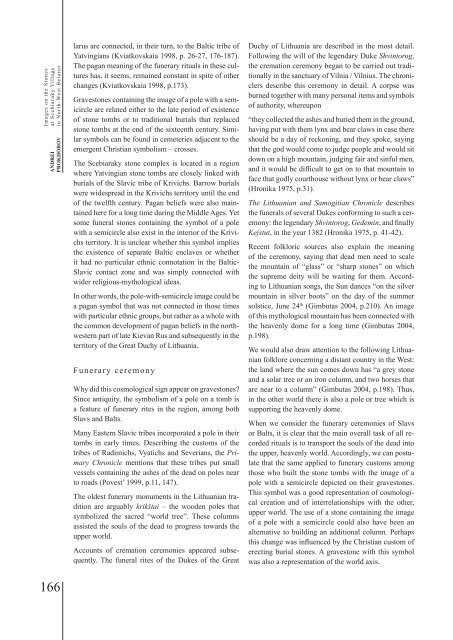BALTICA10
BALTICA10
BALTICA10
Create successful ePaper yourself
Turn your PDF publications into a flip-book with our unique Google optimized e-Paper software.
Images on the Stones<br />
at Scebiaraky Village<br />
in North-West Belarus<br />
ANDREI<br />
PROKHOROV<br />
larus are connected, in their turn, to the Baltic tribe of<br />
Yatvingians (Kviatkovskaia 1998, p. 26-27, 176-187).<br />
The pagan meaning of the funerary rituals in these cultures<br />
has, it seems, remained constant in spite of other<br />
changes (Kviatkovskaia 1998, p.173).<br />
Gravestones containing the image of a pole with a semicircle<br />
are related either to the late period of existence<br />
of stone tombs or to traditional burials that replaced<br />
stone tombs at the end of the sixteenth century. Similar<br />
symbols can be found in cemeteries adjacent to the<br />
emergent Christian symbolism – crosses.<br />
The Scebiaraky stone complex is located in a region<br />
where Yatvingian stone tombs are closely linked with<br />
burials of the Slavic tribe of Krivichs. Barrow burials<br />
were widespread in the Krivichs territory until the end<br />
of the twelfth century. Pagan beliefs were also maintained<br />
here for a long time during the Middle Ages. Yet<br />
some funeral stones containing the symbol of a pole<br />
with a semicircle also exist in the interior of the Krivichs<br />
territory. It is unclear whether this symbol implies<br />
the existence of separate Baltic enclaves or whether<br />
it had no particular ethnic connotation in the Baltic-<br />
Slavic contact zone and was simply connected with<br />
wider religious-mythological ideas.<br />
In other words, the pole-with-semicircle image could be<br />
a pagan symbol that was not connected in those times<br />
with particular ethnic groups, but rather as a whole with<br />
the common development of pagan beliefs in the northwestern<br />
part of late Kievan Rus and subsequently in the<br />
territory of the Great Duchy of Lithuania.<br />
Funerary ceremony<br />
Why did this cosmological sign appear on gravestones?<br />
Since antiquity, the symbolism of a pole on a tomb is<br />
a feature of funerary rites in the region, among both<br />
Slavs and Balts.<br />
Many Eastern Slavic tribes incorporated a pole in their<br />
tombs in early times. Describing the customs of the<br />
tribes of Radimichs, Vyatichs and Severians, the Primary<br />
Chronicle mentions that these tribes put small<br />
vessels containing the ashes of the dead on poles near<br />
to roads (Povest’ 1999, p.11, 147).<br />
The oldest funerary monuments in the Lithuanian tradition<br />
are arguably krikštai – the wooden poles that<br />
symbolized the sacred “world tree”. These columns<br />
assisted the souls of the dead to progress towards the<br />
upper world.<br />
Accounts of cremation ceremonies appeared subsequently.<br />
The funeral rites of the Dukes of the Great<br />
Duchy of Lithuania are described in the most detail.<br />
Following the will of the legendary Duke Shvintorog,<br />
the cremation ceremony began to be carried out traditionally<br />
in the sanctuary of Vilnia / Vilnius. The chroniclers<br />
describe this ceremony in detail. A corpse was<br />
burned together with many personal items and symbols<br />
of authority, whereupon<br />
“they collected the ashes and buried them in the ground,<br />
having put with them lynx and bear claws in case there<br />
should be a day of reckoning, and they spoke, saying<br />
that the god would come to judge people and would sit<br />
down on a high mountain, judging fair and sinful men,<br />
and it would be difficult to get on to that mountain to<br />
face that godly courthouse without lynx or bear claws”<br />
(Hronika 1975, p.31).<br />
The Lithuanian and Samogitian Chronicle describes<br />
the funerals of several Dukes conforming to such a ceremony:<br />
the legendary Shvintorog, Gedemin, and finally<br />
Kejstut, in the year 1382 (Hronika 1975, p. 41-42).<br />
Recent folkloric sources also explain the meaning<br />
of the ceremony, saying that dead men need to scale<br />
the mountain of “glass” or “sharp stones” on which<br />
the supreme deity will be waiting for them. According<br />
to Lithuanian songs, the Sun dances “on the silver<br />
mountain in silver boots” on the day of the summer<br />
solstice, June 24 th (Gimbutas 2004, p.210). An image<br />
of this mythological mountain has been connected with<br />
the heavenly dome for a long time (Gimbutas 2004,<br />
p.198).<br />
We would also draw attention to the following Lithuanian<br />
folklore concerning a distant country in the West:<br />
the land where the sun comes down has “a grey stone<br />
and a solar tree or an iron column, and two horses that<br />
are near to a column” (Gimbutas 2004, p.198). Thus,<br />
in the other world there is also a pole or tree which is<br />
supporting the heavenly dome.<br />
When we consider the funerary ceremonies of Slavs<br />
or Balts, it is clear that the main overall task of all recorded<br />
rituals is to transport the souls of the dead into<br />
the upper, heavenly world. Accordingly, we can postulate<br />
that the same applied to funerary customs among<br />
those who built the stone tombs with the image of a<br />
pole with a semicircle depicted on their gravestones.<br />
This symbol was a good representation of cosmological<br />
creation and of interrelationships with the other,<br />
upper world. The use of a stone containing the image<br />
of a pole with a semicircle could also have been an<br />
alternative to building an additional column. Perhaps<br />
this change was influenced by the Christian custom of<br />
erecting burial stones. A gravestone with this symbol<br />
was also a representation of the world axis.<br />
166
















